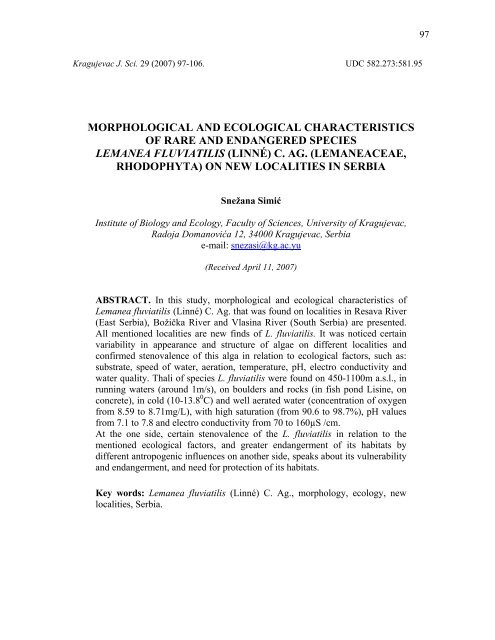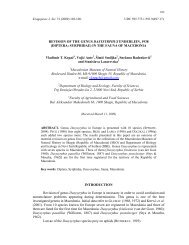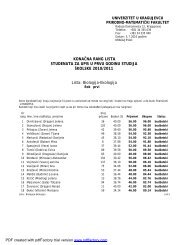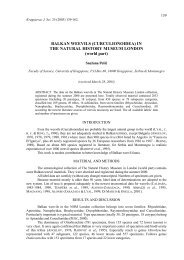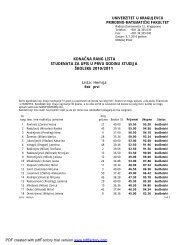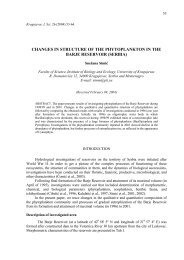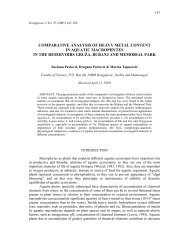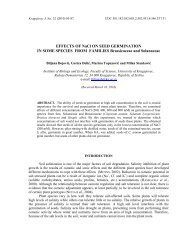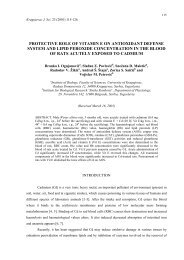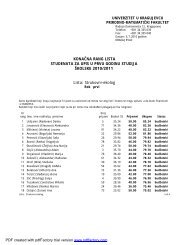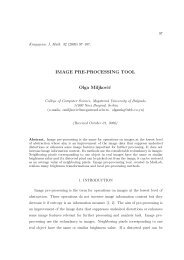morphological and ecological characteristics of rare
morphological and ecological characteristics of rare
morphological and ecological characteristics of rare
You also want an ePaper? Increase the reach of your titles
YUMPU automatically turns print PDFs into web optimized ePapers that Google loves.
97<br />
Kragujevac J. Sci. 29 (2007) 97-106. UDC 582.273:581.95<br />
MORPHOLOGICAL AND ECOLOGICAL CHARACTERISTICS<br />
OF RARE AND ENDANGERED SPECIES<br />
LEMANEA FLUVIATILIS (LINNÉ) C. AG. (LEMANEACEAE,<br />
RHODOPHYTA) ON NEW LOCALITIES IN SERBIA<br />
Snežana Simić<br />
Institute <strong>of</strong> Biology <strong>and</strong> Ecology, Faculty <strong>of</strong> Sciences, University <strong>of</strong> Kragujevac,<br />
Radoja Domanovića 12, 34000 Kragujevac, Serbia<br />
e-mail: snezasi@kg.ac.yu<br />
(Received April 11, 2007)<br />
ABSTRACT. In this study, <strong>morphological</strong> <strong>and</strong> <strong>ecological</strong> <strong>characteristics</strong> <strong>of</strong><br />
Lemanea fluviatilis (Linné) C. Ag. that was found on localities in Resava River<br />
(East Serbia), Božička River <strong>and</strong> Vlasina River (South Serbia) are presented.<br />
All mentioned localities are new finds <strong>of</strong> L. fluviatilis. It was noticed certain<br />
variability in appearance <strong>and</strong> structure <strong>of</strong> algae on different localities <strong>and</strong><br />
confirmed stenovalence <strong>of</strong> this alga in relation to <strong>ecological</strong> factors, such as:<br />
substrate, speed <strong>of</strong> water, aeration, temperature, pH, electro conductivity <strong>and</strong><br />
water quality. Thali <strong>of</strong> species L. fluviatilis were found on 450-1100m a.s.l., in<br />
running waters (around 1m/s), on boulders <strong>and</strong> rocks (in fish pond Lisine, on<br />
concrete), in cold (10-13.8 0 C) <strong>and</strong> well aerated water (concentration <strong>of</strong> oxygen<br />
from 8.59 to 8.71mg/L), with high saturation (from 90.6 to 98.7%), pH values<br />
from 7.1 to 7.8 <strong>and</strong> electro conductivity from 70 to 160µS /cm.<br />
At the one side, certain stenovalence <strong>of</strong> the L. fluviatilis in relation to the<br />
mentioned <strong>ecological</strong> factors, <strong>and</strong> greater endangerment <strong>of</strong> its habitats by<br />
different antropogenic influences on another side, speaks about its vulnerability<br />
<strong>and</strong> endangerment, <strong>and</strong> need for protection <strong>of</strong> its habitats.<br />
Key words: Lemanea fluviatilis (Linné) C. Ag., morphology, ecology, new<br />
localities, Serbia.
98<br />
INTRODUCTION<br />
Freshwater red algae (Rhodophyta) appear to be endangered algal group in many<br />
countries. These algae can characterize their environments in many ways <strong>and</strong> are connected<br />
to their different preferences for physical, chemical <strong>and</strong> biological variables (ELORANTA &<br />
KWANDRANS 2004).<br />
Data about distribution <strong>of</strong> L. fluviatilis indicate that this species was found on<br />
relatively small number <strong>of</strong> localities in Europe: (PEVALEK, 1916; VOUK 1953; PETROVSKA,<br />
1966; MATONIČKIN & PAVLETIĆ, 1960; WHITHON, 1975; STARMACH, 1977; KAWECKA,<br />
1980; SABATER et al., 1989; ELORANTA & KWANDRANS, 1995; ROTT et al., 1999, KUČERA<br />
& MARVAN, 2004) <strong>of</strong> the North Amerika (VIS & SHEATH, 1992), South America (Brasil)<br />
(NECCHI et al. 1999) <strong>and</strong> Australia (ENTVISLE, 1989).<br />
In Serbia, genus Lemanea (species Lemanea fluviatilis) was recorded at the first<br />
time in Crnovrška River (Stara planina) (SIMIĆ, 1995), <strong>and</strong> after that on some other<br />
localities in rivers <strong>of</strong> East (Golema River, Svrljiški Timok River <strong>and</strong> Mlava River) <strong>and</strong><br />
West Serbia (Studenica) (SIMIĆ, 2002).<br />
Knowledge about small-number localities <strong>of</strong> species L. fluviatilis with specific<br />
<strong>ecological</strong> conditions contributed to including <strong>of</strong> this algae in Red list <strong>of</strong> algae, in some<br />
countries, where this species is defined as a vulnerable (V) (SIEMINSKA, 1992) or as<br />
(endangered) EN (HINDAK, 2001).<br />
The aim <strong>of</strong> this study is to present new data about <strong>morphological</strong> <strong>and</strong> <strong>ecological</strong><br />
<strong>characteristics</strong> <strong>of</strong> L. fluviatilis populations that were found on new finds in rivers <strong>of</strong> Serbia.<br />
MATERIAL AND METHODS<br />
Algological material, in which species L. fluviatilis was recorded, was collected in<br />
Resava River (South Serbia), on two localities, as well as, per one locality on Božička<br />
River <strong>and</strong> Vlasina River (South Serbia).<br />
Physical <strong>and</strong> chemical <strong>characteristics</strong> on investigated localities were measured by<br />
field laboratory HANA INSTRUMENTS (APHA 1985). These measurements included:<br />
velocity, temperature <strong>of</strong> water, pH, electro conductivity <strong>of</strong> water, BOD, saturation with <strong>and</strong><br />
concentration <strong>of</strong> oxygen <strong>and</strong> concentration <strong>of</strong> biogenic salts (phosphates <strong>and</strong> nitrates)<br />
(Table 1).<br />
All samples were collected from running water with turbulent flow (weirs <strong>and</strong><br />
riffles). The algological material was fixed in 4% formaldehyde <strong>and</strong> is stored in the<br />
Algological collection <strong>of</strong> the Institute <strong>of</strong> Biology <strong>and</strong> Ecology, Faculty <strong>of</strong> Science,<br />
University <strong>of</strong> Kragujevac. For taxa identification the material was magnified 640 times <strong>and</strong><br />
analyzed with a C. Zeiss-Amplival microscope. Measurements were performed with ocular<br />
micrometer whereby the material was magnified 160-640 times.<br />
In the laboratory we recorded the following <strong>morphological</strong> characters (Table 2):<br />
presence <strong>and</strong> incidence <strong>of</strong> branched plants, presence <strong>of</strong> a stalk, plant length, nodal diameter<br />
(ND), internodal diameter (ID), presence <strong>of</strong> axial cortical filaments, arrangement <strong>of</strong><br />
spermatangial sori, length <strong>and</strong> diameter <strong>of</strong> carpospores (VIS & SHEATH, 1992; KUMANO,<br />
2003; KUČERA & MARVAN, 2004)
99<br />
RESULTS AND DISCUSION<br />
Description <strong>of</strong> the sampling localities<br />
The Resava River is 70 km long right tributary <strong>of</strong> the River Velika Morava. Its<br />
flow covers an average area <strong>of</strong> about 450km 2 . It is one <strong>of</strong> the largest rivers <strong>of</strong> the East<br />
Serbia. The Resava River, with its tributaries represents river basin in the Lisine ravine,<br />
where the biggest spring, called the Great spring occurs. The Resava River sources from<br />
Kučajske Mountains, <strong>and</strong> in upper part <strong>of</strong> its course is virgin wood <strong>and</strong> Vitanovac<br />
reservation. On protected area <strong>of</strong> around 38 h, huge beech trees grow. Canyon part <strong>of</strong><br />
Resava River is 25 km long, <strong>and</strong> after that it is calm river running alongside Manasija<br />
Monastery, Despotovac town <strong>and</strong> Svilajnac town, <strong>and</strong> after 65km flows into West Morava.<br />
Water <strong>of</strong> this river is exceptionally clear, so it together with ravine <strong>of</strong> Suvaja River<br />
represents strict nature reservation <strong>of</strong> I category <strong>and</strong> it is under protection <strong>of</strong> our state.<br />
In May 1st 2003, thali <strong>of</strong> the species L. fluviatilis were found in trout fish pond<br />
“Lisine” (locality RR1), on concrete substrate, in zone <strong>of</strong> surf, on depth from 10 to 15cm.<br />
Fish pond is located on 450m a.s.l. Water depth <strong>of</strong> fish pond was from 1.5 to 2m (Table 1).<br />
In 12 April 2004, thali <strong>of</strong> the species L. fluviatilis were found in the river, on 700<br />
a.s.l., (locality RR2) on locality with wide from 2 to 6 m, depth from 0.3 to 1m (thali were<br />
always found on rocks, which were flooded by water, on depth <strong>of</strong> a few centimeters), in<br />
water <strong>of</strong> 10 0 C temperature, pH 7.8, concentration <strong>of</strong> dissolved oxygen 8,59mg/l, saturation<br />
90,6% <strong>and</strong> electro conductivity 160µS/cm (Table 1).<br />
Božička River (BR) sources on south-east slope <strong>of</strong> Vlasina plateau, after that fuses<br />
with Ljubatska River in Dragovištica River, which after some kilometers leaves teritory <strong>of</strong><br />
Serbia <strong>and</strong> passes into Bulgaria.<br />
In 11 July 2003 <strong>and</strong> 15 August 2004, thali <strong>of</strong> the species L. fluviatilis were found on<br />
over 1100m a.s.l., on part <strong>of</strong> river where width is from 3-5m, depth from 0.1 do 0.7m,<br />
speed 1.1m. pH values measured in 11 July 2003 was 7.3, <strong>and</strong> 7.1 in 15 August 2004,<br />
concentration <strong>of</strong> oxygen 10.87mg/l, versus 8.71mg/l, saturation 99.2 <strong>and</strong> 98.4%,<br />
respectively, with small concentration <strong>of</strong> nutrients (nitrates 4.4 <strong>and</strong> 4.6mg/l, <strong>and</strong> fosfates<br />
0.400 <strong>and</strong> 0.443mg/l. Electro conductivity was 90µS/cm <strong>and</strong> 70µS/cm, respectively (Table<br />
1).<br />
Vlasina River (VR) is situated in the mountain region <strong>of</strong> the south-east part <strong>of</strong><br />
Serbia. Its source is below the dam on the Vlasinsko Jezero reservoir, at 1210m a.s.l. <strong>and</strong><br />
the month is near town Leskovac in the Južna Morava River. Primarily, Vlasina River was<br />
a natural arm <strong>of</strong> a Vlasina pest-bog. After the construction <strong>of</strong> the dam on the Vlasina River<br />
in 1949, 2km downstream from the place where it flowed out from the peat-bog the course<br />
<strong>of</strong> the river was out from the newly created reservoir. Geological substratum <strong>of</strong> the river<br />
bottom is mainly composed <strong>of</strong> crystalline shists. The main components <strong>of</strong> these rocs are<br />
sercite, chlorite, quartz <strong>and</strong> albite. Due to geological substratum, the hole area is permeate<br />
with a dense network <strong>of</strong> periodical <strong>and</strong> permanent streams.<br />
In 15.08.2004, the thali were found on locality below fish pond, at temperature<br />
12 0 C <strong>and</strong> pH 7.2, on 1150m a.s.l (Table 1).
100<br />
Table 1. Physical <strong>and</strong> chemical parameters <strong>of</strong> streams from which Lemanea fluviatilis<br />
plants were collected<br />
Rivers/<br />
Resava River<br />
Vlasina<br />
Božička River<br />
River<br />
Lokality RR1 RR2<br />
BR<br />
Date/<br />
Years<br />
1. 05<br />
2003.<br />
12. 04.<br />
2004.<br />
11. 07.<br />
2003.<br />
15.08.<br />
2004.<br />
15. 08.<br />
2004.<br />
Altitude (m) 450 800 1100 1100 1000<br />
Max. bed width (m) 6.0 5 3.5<br />
Max depth (m) 1.0 0.70 0.70<br />
Velocity (m/s) 1.5 1.1 1.1 1.1<br />
Temperat. <strong>of</strong> waters<br />
( 0 C)<br />
10 10.2 13.8<br />
Disolved oxygen<br />
(mg/l)<br />
8.59 10.87 8.51<br />
O 2 ( %) 90.6 99.2 98.4<br />
BOD 5 (mg/l) 0.5 0.4<br />
pH 7.8 7.3 7.1<br />
Phosphate (P) (mg/l) 0.058 0.400 0.443<br />
Nitrate ( N) (mg/l) 4.7 4.4 4.6<br />
Conductivity (µS/cm) 160 90 70<br />
Description <strong>of</strong> the alga<br />
The recent taxonomic concept <strong>of</strong> the family Lemaneaceae is based on both<br />
<strong>morphological</strong> <strong>and</strong> ultrastructural characters (VIS & SHEATH, 1992, SHEATH et al., 1996,<br />
ELORANTA & KWANDRANS, 2002; KUMANO, 2003). However, identification <strong>of</strong> the species<br />
is difficult (VIS & SHEATH, 1992). The <strong>morphological</strong> variability <strong>and</strong> its subjective<br />
evaluation does not allow a clear delimitation <strong>of</strong> the species. Thus, for delimiting species <strong>of</strong><br />
Lemaneaceae both the morphology <strong>of</strong> vegetative <strong>and</strong> reproductive features <strong>and</strong><br />
ultrastructural <strong>and</strong> molecular information is required (CARMONA & NECCHI, 2002).<br />
On the occasion <strong>of</strong> review <strong>of</strong> algological material <strong>and</strong> comparation <strong>of</strong><br />
<strong>morphological</strong> <strong>and</strong> anatomical features, some varibility in relation to apearrance <strong>of</strong> algae<br />
on different localities, as well as in diffferent periods <strong>of</strong> the year was recorded (Table 2).<br />
Adult plants are in clods, in form <strong>of</strong> needle, to 12 cm height (on locality Valasina<br />
maximum was 4.5cm), unbranched or branched (on locality Resava <strong>and</strong> secondarly). The<br />
thali get narrower to apex in thin thread, <strong>and</strong> in base in thin, cilindric stem. They do not<br />
have cortex around central axis cell. Their color is from olive green to violet green. Width<br />
<strong>of</strong> nodus is from 400 to 900µm, <strong>and</strong> <strong>of</strong> internodus is from 210 do 770µm (ratio<br />
nodus:internodus is from 1.16 to 1.33). Knotty swellings are moderate visible, less in<br />
spring than in summer months. Lenght <strong>of</strong> carpospore is from 16 to 54µm, <strong>and</strong> width from<br />
9.9 to 39.0µm.<br />
Primary stadium (Chantransia stadium) was found on st<strong>and</strong>, on localities Resava in<br />
april <strong>and</strong> Božička River in july. It is 1-2 mm long, clod-like, branched, without hairs on<br />
the top. Mature individuals grow from lower cells <strong>of</strong> primary stadium. Cell are 16.5 do<br />
24µm long, 9.9 do 16 µm width (ratio lenght:width is 1.7 to 3.3). Monosporangia unknown.<br />
VR
Distribution <strong>and</strong> ecology <strong>of</strong> species L. fluviatilis<br />
On the base <strong>of</strong> relatively small number <strong>of</strong> data from contemporary literature, as well<br />
as new data presented in this study, it can be noticed that the L. fluviatilis is stenovalent<br />
when are in questions <strong>ecological</strong> factors, such as: type <strong>of</strong> water ecosystem, type <strong>of</strong><br />
substrate, depth where thali develope, speed <strong>of</strong> water, aeration, temperature, pH <strong>and</strong> electro<br />
conductivity <strong>of</strong> water.<br />
Populations <strong>of</strong> species L. fluviatilis were found in hill-mountain rivers <strong>and</strong> streams<br />
<strong>of</strong> Europe, North <strong>and</strong> South America, on altitudes from 305 to 888m (SABATER et al.,<br />
1989; VIS & SHEATH, 1992; NECCHI et al., 1999; KUČERA & MARVAN, 2004). In Serbia,<br />
the thali <strong>of</strong> species L. fluviatilis were found on latitudes from 500 to1100 m. Rivers in<br />
which this alga was found are mainly to 10m width, depth to 1m, open or partialy shaded<br />
(SABATER et al., 1989; VIS & SHEATH1992; NECCHI et al., 1999; SIMIĆ, 2002; KUČERA &<br />
MARVAN 2004). ELORANTA & KVADRANS (2004) reported data that this species was found<br />
in larger, open river.<br />
This algae always has been found on stable <strong>and</strong> hard substrates (stones, large rocks,<br />
<strong>and</strong> also concrete blocks or walls). The species was observed in Chezch Republic on stony<br />
substrates (boulders <strong>and</strong> cobbles) in riffles or weirs on depth from 2 to 15cm (KUČERA &<br />
MARVA 2004).<br />
It is known that red algae, <strong>and</strong> particularly algae <strong>of</strong> Lemaneaceae family generaly<br />
were found in running, turbulent waters. It was shown that in the rivers <strong>of</strong> Serbia, this<br />
species was found on localities where measured speed <strong>of</strong> water was from 0.4 (in Mlava<br />
River, at locality M1) to 1.40m/s (in Crnovrška River, at locality CR11) (SIMIC, 2002).<br />
Also, in the rivers <strong>of</strong> Finl<strong>and</strong>, it was found at different speeds <strong>of</strong> water (min. 0.20 - max.<br />
1.90m/s) (ELORANTA & KWANDRANS, 1996). American authors (VIS & SHEATH, 1992)<br />
cited similar data for this species. However, it was noticed that thali <strong>of</strong> this algae were<br />
always found in those parts <strong>of</strong> river’s course where water speed was greater than average<br />
measured speed for that locality (around 1m/s), as well as, on places which were exposed<br />
to strong blow <strong>of</strong> water, or at least to pounding, that is places with high aeration. The thali<br />
were always found on small depth from 2 to 15cm, <strong>and</strong> sometimes in direct contact with<br />
air.<br />
Need <strong>of</strong> red algae for high concentration <strong>of</strong> oxygen confirme data that show<br />
frequency <strong>and</strong> coverness <strong>of</strong> this algae are much greater in water with high concentration <strong>of</strong><br />
oxygen (SHEATH, 1984; SABATER et al., 1989; NECCHI et al., 1999). In rivers <strong>of</strong> Brasil,<br />
80% <strong>of</strong> recorded species were found in waters where saturation <strong>of</strong> oxygen was from 60 to<br />
100% (NECCHI et al., 1999) . At localities in Resava River <strong>and</strong> Božička River, the thali <strong>of</strong><br />
L. fluviatilis have developed well in good aerated water (concentration <strong>of</strong> oxygen from 8.59<br />
to 8.71mg/l, high saturation from 90, 6 do 98.7%).<br />
Also, many investigations confirmed stenovalence <strong>of</strong> this species in relation to<br />
temperature. This species prefers cold water (mainly under 15 0 C). There are interesting<br />
data <strong>of</strong> Vis i Sheath (1992), who found this algae on habitats where measured temperature<br />
<strong>of</strong> water was above 15 0 C (max. 24 0 C), in rivers <strong>of</strong> Ontario State (North America).<br />
101
102<br />
Table 2. Characteristics <strong>of</strong> populations <strong>of</strong> Lemanea fluviatilis<br />
Locality<br />
Stalced od<br />
plants<br />
Branched<br />
plants<br />
Plant length (cm) Nodial Diameter (µm) Internodal Diameter (µm)<br />
Range<br />
mean<br />
±SD<br />
Axial cortical<br />
filaments<br />
Spermatangial<br />
sori<br />
arrangement<br />
Range<br />
mean<br />
±SD<br />
Range<br />
mean±SD<br />
Ratio<br />
ND:ID<br />
Resava River<br />
(RR1) yes<br />
Resava River<br />
(RR2) yes<br />
Božička River<br />
17.07 2003. yes<br />
Božička River<br />
15.08 2004. yes<br />
Vlasina River<br />
yes<br />
yes 5,0 12 8,0 3,0 no patches 500 900 603,6 112,6 340 620 451,8 80,6 1,33<br />
yes 1,5 10 4,8 2,5 no patches 620 880 700,0 87,0 540 770 605,6 72,3 1,16<br />
no/<br />
yes 1,2 5 2,9 1,0 no patches 400 700 545,8 81,2 210 600 423,6 114 1,29<br />
no/<br />
yes 1.5 4.5 3.4 1.0 no patches 500 700 598 71,2 430 600 506 70,2 1.18<br />
no/<br />
yes 1,5 10 4,8 2,3 no patches 500 700 566,3 61,9 380 530 451,9 54,9 1,25
Some stenovalence can be observed in relation to electro conductivity. There are<br />
records <strong>of</strong> this algae in habitats with water electro conductivity to 300µS/cm (VIS &<br />
SHEATH, 1992), <strong>and</strong> also, to 400µS/cm (SIMIĆ, 2002), as well as here presented results<br />
(from 70 to 160µS/cm). Exceptions are data <strong>of</strong> ELORANTA <strong>and</strong> KWANDRANS (1996), <strong>and</strong><br />
according them the L. fluviatilis is very tolerant in relation to electro conductivity (from<br />
150 to 3 056µS/cm).<br />
ROTT <strong>and</strong> colleagues (1999) characterized the species L. fluviatilis, in relation to<br />
phoshorus, as indicator <strong>of</strong> oligo-mesotrophic water (indicator height G-1). In relation to<br />
nitrogen, they gave data that the this species is good indicator <strong>of</strong> oligotrophic waters (G-<br />
4).<br />
The thali <strong>of</strong> this alga were found in community with Chamaesiphon polonicus,<br />
Homeaeothrix janthina, Hydrurus foetidus (Crnovrška River), than together with thali <strong>of</strong><br />
species <strong>of</strong> genus Paralemanea (Golema River, Studenica), Vaucheria <strong>and</strong> Cladophora<br />
glomerata (Svrljiški Timok River), as well as in rich community <strong>of</strong> silicate algae (SIMIĆ,<br />
2002).<br />
On the thali <strong>of</strong> L. fluviatilis (on localities Vlasina River <strong>and</strong> Božička River),<br />
macroscopicaly visible colonies <strong>of</strong> epifitic algae in form <strong>of</strong> oliva green warts with<br />
diameter from 2 to 5 mm, were observed. By microscopical review, in common hard<br />
mucus, silicate algae <strong>of</strong> genera Navicula, Cymbella <strong>and</strong> Ceratoneis were found. In<br />
material collected on locality Vlasina, gelatinous oliva green colonies Nostoc sp. with<br />
diameter to 1cm were recorded. By review <strong>of</strong> algological material from fish pond<br />
“Lisine”, threads <strong>of</strong> Ulothrix zonata (Chlorophyta) <strong>and</strong> Vaucheria sp., as well as, algae <strong>of</strong><br />
genera Diatoma <strong>and</strong> Gomphonema were observed in base <strong>of</strong> the thalus L. fluviatilis.<br />
At the one side, known stenovalence <strong>of</strong> this alga in relation to mentioned<br />
<strong>ecological</strong> factors, <strong>and</strong> at the other side, more <strong>and</strong> more increased endangerement <strong>of</strong><br />
habitats where this alga lives by different antropogenic influences are the basic reasons<br />
why this alga is on some existing Red list <strong>of</strong> algae defined as vulnerable (V) (SIEMINSKA<br />
1992) or as EN (endangered) (HINDAK, 2001).<br />
New habitats <strong>of</strong> this species, which were mentioned in this study, as well as,<br />
habitats where it was formerly recorded in Serbia (SIMIĆ, 2002) are located mainly on<br />
areas <strong>of</strong> protected nature (Resava River – l<strong>and</strong>scape <strong>of</strong> extraordinarly <strong>characteristics</strong>), so<br />
completelly expectation exists that these habitats will stay unendangered by further respect<br />
<strong>of</strong> measures for protection <strong>and</strong> decrease <strong>of</strong> antropogenic influences.<br />
However, in practice, without respect to some level <strong>of</strong> protection, some activities<br />
occure in protected areas, which can lead do endangerement <strong>of</strong> this species, but also <strong>of</strong><br />
greater number <strong>of</strong> other important species that charaterized that protected natural property.<br />
Habitats <strong>of</strong> this species on Crnovrška River <strong>and</strong> Golema River on territory Stara planina<br />
(which is declared as Natural park in 1997), where at the first time genus Lemanea was<br />
recorded at territory <strong>of</strong> Serbia <strong>and</strong> Montenegro, are directly <strong>and</strong> indirectly endangered,<br />
because in immediate vicinity there are activities in formation sports-recreative center,<br />
which can lead to significant negative antropogenic influences.<br />
103
104<br />
CONCLUSION<br />
New data about morphology, ecology <strong>and</strong> biogeography <strong>of</strong> the L. fluviatilis<br />
presented in this study, together with already existing data show that this species, which is<br />
relatively very <strong>rare</strong> in the world, as well as in Serbia, stenovalent in relation to greater<br />
number <strong>of</strong> <strong>ecological</strong> factors (altitude, substrate, speed <strong>of</strong> water, aeration, temperature, pH,<br />
electro conductivity <strong>and</strong> water quality). It speaks about its vulnerability, need for knowing<br />
<strong>of</strong> its ecology <strong>and</strong> distribution, as well as necessity for protection <strong>of</strong> its habitats.<br />
ACKNOWLEDGMENT<br />
This work was supported by the directorate for Environmental Protection <strong>of</strong> the Ministry<br />
<strong>of</strong> Science <strong>and</strong> Environmental Protection <strong>of</strong> the Republic <strong>of</strong> Serbia (Project “Establishing<br />
Typology <strong>of</strong> Running Waters in Serbia” N 0 143023).<br />
References:<br />
[1] AMERICAN PUBLIC HEALTH ASSOCIATION (1985). St<strong>and</strong>ard Methods the Examination<br />
<strong>of</strong> Water <strong>and</strong> Wastewater. 17th Ed. American Public Health Association.<br />
Washington. 1134 pp.<br />
[2] ELORANATA, P. & KWADRANS, J. (1996): Distribution <strong>and</strong> ecology <strong>of</strong> freshwater red<br />
algae (Rhodophyta) in some central Finnish rivers. Nord. J. Bot. 16: 107-117.<br />
[3] ELORANATA, P. & KWADRANS, J. (2002): Notes on some interesing freshwater<br />
Rhodohyta from Finl<strong>and</strong>. - Algol. Stud. 105: 95-109.<br />
[4] ELORANATA, P. & KWADRANS, J. (2004): Indicator value <strong>of</strong> freshwater red algae in<br />
running waters for water quality assessment. Oceanological <strong>and</strong> Hydrobiological<br />
Studies. 33 (1): 47-54.<br />
[5] ENTWISLE, T. J. (1989): Macroalgae in the Yarra river basin: flora <strong>and</strong> distribution.<br />
Proceedings <strong>of</strong> the Royal Society <strong>of</strong> Victoria 101: 1-76.<br />
[6] HINDAK, F. (2001) Checklist <strong>of</strong> non-vascular <strong>and</strong> vascular plants <strong>of</strong> Slovakia. Version<br />
1.0. http://ibot.sav.sk/page/intro.htm#algae<br />
[7] KAWECKA, B. (1980). Sessile algae in European mountain streams. 1. The <strong>ecological</strong><br />
<strong>characteristics</strong> <strong>of</strong> communities. Acta Hydrobiol. 22 (4): 361-420.
105<br />
[8] KUČERA, P. & MARVAN, P. (2004): Taxonomy <strong>and</strong> distribution <strong>of</strong> Lemanea <strong>and</strong><br />
Paralemanea (Lemaneaceae, Rhodophyta) in the Czech Republic. Preslia, Praha 76:<br />
163-174.<br />
[9] KUMANO, S. (2003): Frashewater Red Algae <strong>of</strong> the World. Biopress ltd. Bristol.<br />
[10] MATONIČKIN, I. & PAVLETIĆ, Z. (1960). Sudelovanje pojedinih životinjskih i biljnih<br />
skupina u izgradnji životnih zajednica na sedrenim i erozijskim slapovima Bosne i<br />
Hercegovine. God. Biološ. Inst. Univ. Sarajevo. XIII (1-2): 41-62.<br />
[11] NECCHI, O. JR., BRANCO, Z. C. Z. & BRANCO, Z. H. L. (1999). Distribution <strong>of</strong><br />
Rhodophyta in streams from São Paulo state, southeastern Brazil. Arch. Hydrobiol.<br />
147 (1): 73-89.<br />
[12] NECCHI, O. JR., BRANCO, Z. C. Z. & BRANCO, Z. H. L. (2000). Distribution <strong>of</strong> stream<br />
macroalgae in São Paulo State, southestern Brazil. Algological Studies. 97: 43-57.<br />
[13] PETROVSKA, LJ. (1966). Rod<strong>of</strong>iceii vo algenata flora na Makedonija. Fragm. Balk. 5:<br />
189-194.<br />
[14] PEVALEK, I. (1916). O biologiji i geografskom rasprostranjenju alga u Sjevernoj<br />
Hrvatskoj. Prirodoslovna istraživanja Hrv. i Slav. 8: 25-55.<br />
[15] ROTT, E., PIPP, E., PHISTER, P., VAN DAM, H., ORTLER, K., BINDER, N. & PALL, K.<br />
(1999): Indicationslisten für Aufwuchsalgen in österreichischen Flieβgewässern.Teil<br />
2: Trophieinindikation sowie geohemishche Präferenz, taxonomische und<br />
toxikologische Anmerkungen. WWK. Bundesministerium für L<strong>and</strong>'und<br />
forstwirtschaft, Wien. 248 pp.<br />
[16] SABATER, S., ABOAL, M. & CAMBRA, J. (1989). Nuevas observaciones de Rod<strong>of</strong>iceas<br />
en aquas epikontinentales del ne y se de Espana. Limnética. 5: 93-100.<br />
[17] SHEATH, R. G. (1984). The biology <strong>of</strong> freshwater red algae. Prog. Phycol. Res. 3: 89-<br />
157.<br />
[18] SIEMIŃSKA J. (1992). Red list <strong>of</strong> threateened algae in Pol<strong>and</strong>. In: List <strong>of</strong> threateened<br />
plants in Pol<strong>and</strong> (2 nd ed.). 7-19. (Eds. Zarzycky, K., Wojewoda, W. & Heinrich, Z.).<br />
Polish Academy <strong>of</strong> Sciences. W. Szafer Institute <strong>of</strong> Botany, Cracow. 7-19.<br />
[19] SIMIĆ, S. (1995). Bentosne zajednice algi Trgoviškog Timoka. Magistarski rad.<br />
Biološki fakultet. Univerzitet u Beogradu. 139 str.<br />
[20] SIMIĆ, S. (2002): Makroalge u tekućicama brdsko-planinskih područja Srbije.<br />
Doktorska disertacija. Univerzitet u Beogradu. Beograd. 215.<br />
[21] STARMACH, K. (1977). Phaeophyta - Rhodophyta. Flora Slodkowodna Polski, 14.<br />
Polska akademia nauk, Warszawa. 444 pp.<br />
[22] VIS, L. M. & SHEATH, G. R. (1992). Systematics <strong>of</strong> the freshwater red algal family<br />
Lemaneacea in North America. Phycologia. 31 (2): 164-179.<br />
[23] VOUK, V. (1953). Slatkovodne rod<strong>of</strong>iceje Jugoslavije. Godišn. Biol. Instituta u<br />
Sarajevu. 5: 437-444.
106<br />
[24] WHITTON, B. A. (1975). Algae.-In. Whitton, B. A. (ed.): River Ecology.-Blackwell<br />
Sci. Publ., Oxford. 81-105.


